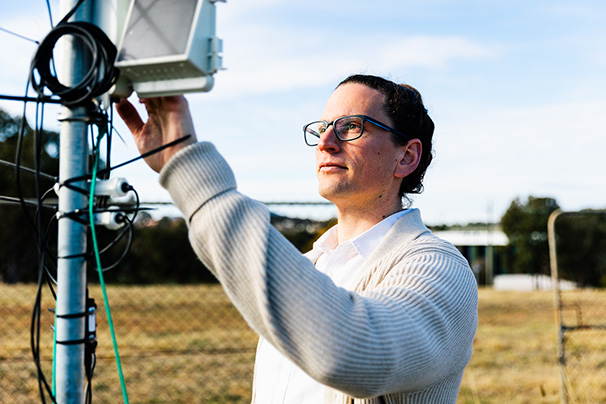University of Canberra PhD Project Analyzes Urban Environmental Pollutants at Bruce Campus
University of Canberra PhD student Joseph O’Connell has spent many rainy days over the last two years collecting water runoff at the Bruce campus – testing water runoff from various surfaces to determine how they contribute to urban pollutant levels.
“I’m also investigating some of the pollutant generating processes, to try and infer why certain surfaces might be contributing more or less pollutants,” said Mr O’Connell. This data will be fed into a stormwater model, with the aim of informing management strategies for urban pollution.
Mr O’Connell has sampled surface water runoff at 30 sites across the Bruce campus, including from roofs, roads, driveways, car parks, footpaths, bike paths, exposed soil, sports fields and paved areas.
“I’ve basically spent the last two years wandering around campus in a raincoat every time it rains,” said Mr O’Connell.
Pollution management has many levels. On the catchment level, this can involve large water infrastructure such as wetlands at the end of a stormwater channel. At the other end of the scale are the contributions of pollutants from urban surfaces, which is the focus of Mr O’Connell’s PhD research.
He is testing the rainfall surface runoff for three types of pollutants: nutrients, sediments and metals. Nutrients – various forms of nitrogen, phosphorus and carbon – are of particular concern because they contribute to algal blooms in lakes. “Sediments act as a physical transport mechanism for pollutants, and heavy metals (such as copper, lead and cadmium) are classed as environmental toxins at certain levels,” Mr O’Connell said.
The sources of the pollutants include atmospheric deposition, traffic (gaseous emissions and particulates from vehicles) and organic deposition (pollutants that are transported by leaves, bark and grass).
The data collection process is similar to Mr O’Connell’s 2021 Honours project, for which he sampled rainfall runoff from about 100 sites around Canberra. Volunteers from the University and the ACT water monitoring group Waterwatch assisted by collecting samples from their own roofs, or from nearby driveways and roads.
To reduce data variability, Mr O’Connell decided to focus on the Bruce campus as a case study for his PhD research. “In this smaller area, I want to find out if these same patterns persist in terms of different surfaces contributing different amounts of pollutants,” he said.
Mr O’Connell has observed that literature studies typically focus on runoff from roofs, roads and sometimes carparks. “It makes sense that they’ve been the primary focus because runoff from these surfaces tend to end up in stormwater drainpipes. What’s been surprising for me is the other surfaces have been largely ignored – I’m trying to fill that gap,” he said.
To analyse the composition of pollutants in the water runoff, Mr O’Connell used instrumentation available at the University’s Centre for Applied Water Science (CAWS). He used a technique called inductively coupled plasma mass spectrometry (ICP-MS) to identify trace metals. For the sediments, he filtered the water samples and dried out the product to measure its mass.
A Total Organic Carbon (TOC) analyser was used to measure the carbon dioxide released after burning the sample to infer its carbon levels. To analyse the other nutrients, he used a flow injection analyser. “It’s a little machine that adds in the right reagents and then puts it through a spectrophotometer to analyse the colour change, which correlates with the amount of nutrients in that sample,” he said.
To examine pollutant generating processes, Mr O’Connell is carrying out experiments that look at deposition onto roads. Assisted by Dr Rod Ubrihien from CAWS and undergraduate Bachelor of Applied Science in Forensic Studies student Leanna Dettori, he is currently testing and comparing two sampling methods.
One method that is commonly used in literature studies involves vacuuming the road surface and testing the ‘dust’ for pollutants.
A more novel approach involves laying down Teflon sheets, driving over them, and sampling the deposited pollutants. “Obviously the two methods are very different, so we’re carrying out method development to see which is better,” said Mr O’Connell.
As part of his PhD, Mr O’Connell is undertaking an internship with the ACT Government Office of Water to implement a spatial analysis of the Lake Tuggeranong Catchment. The Office is focusing on improving water quality issues in Lake Tuggeranong, and Mr O’Connell is modelling how water runoff from different surfaces connects to stormwater drains and the lake.
“The connectivity of the surface is very influential in terms of how much pollutant it’s actually contributing,” he said.
This spatial analysis will be used to develop a stormwater mapping technique that can be applied to different sites – Mr O’Connell will use this method for his case study.
He is planning to publish his research findings and is optimistic about the applications for pollution management. “In essence, I want this data to inform urban pollution management,” he said.

